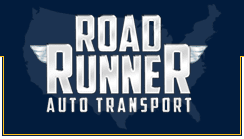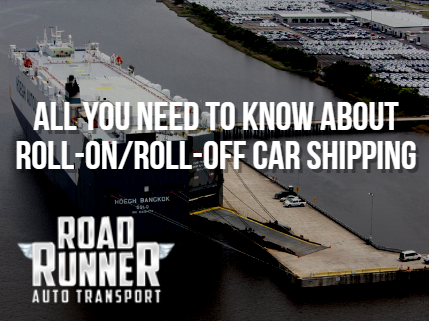
The trusted name in vehicle shipping for over 30 years!
- Track a Shipment
- Dealer Login
- Carrier Login
Speak with a shipping expert
(888) 777-2123

What Is Roll on Roll off Car Shipping (RoRo)? All You Need to Know
Posted on 06/29/2021
Roll-On and Roll-Off Basics
Types of RORO ships
Types of Vehicles Best Suited for RORO Shipping
Loading and Unloading Processes in RORO Shipping
The History of RORO Auto Transport
RoadRunner: Roll-On and Roll-Off Car Shipping
Frequently Asked Questions

Roll-On and Roll-Off Basics
Roll-on and roll-off, otherwise known as RORO, is a type of container shipping used for static cargo, like vehicles, where the item being shipped can be moved onto a ship via a ramp. RORO services are only used for shipping where transporting the car overseas is necessary. So, if you were shipping your car to or from Hawaii, your car would be using RORO shipping services at some point in the transport process.
This circumvents the need to lift large items, such as cars with a crane, and move them onto the ship, a process known as break bulk. This helps save time and lowers the risk of damaging items shipped on the boat. That sort of shipping is known as LOLO—lift-on and lift-off.
RORO shipping vessels also help lower transit times by avoiding the need for breakbulk operations. Instead of lifting cars onto the ship with a crane, which can be incredibly time-consuming, cars are easily driven onto the boat. This can cut the time loading cars onto a ship in half, which can be considerable if a lot of cars need to be loaded onto the boat and off to the destination port.
Types of RORO Ships
Several types of RORO ships exist, designed to accommodate various types of static cargo and operational needs. The main categories for shipping services include:
- LMSR – Large medium-speed roll-off is a ship specifically designed to have military cargo on board. Some of these have been converted to ship vehicles for civilians.
- ConRO – A ConRO ship is a type of RORO ship where both RORO and LOLO shipping methods are used. The way this works is that containers are stored on top of the ship while vehicles are stored below deck and rolled on.
- RoLo – A roll-on and lift-off ship is a ship that has a deck where cars can be rolled on and off but also has other decks where a crane needs to be used in order to get cargo on and off of the ship.
- ROPAX – This is a type of ship with roll-on and roll-off capabilities for cars but also has the ability to ship passengers. This is what ferries that carry cars are typically referred to as.
The specific type chosen depends on factors like the cargo mix, route, port facilities, and operational requirements. Advances in RORO vessel design continue to optimize loading/unloading efficiency and improve safety standards for vehicle transport over sea routes.
Types of Vehicles Best Suited for RORO Shipping
The distance between the pickup and delivery locations is one of the most significant factors affecting motorcycle shipping costs:
- Longer Distances – Generally result in higher shipping expenses, as they require more fuel, time, and labor.
- Specific Locations – This can impact the cost, as some areas may have limited access or require special permits, leading to increased fees charged by motorcycle shipping companies.
- Remote or Hard-to-Reach Areas – Motorcycle transport companies may charge additional fees to cover the extra time and effort required to navigate these challenges.
- Accurate Pickup and Delivery Locations – When requesting a motorcycle shipping quote, provide accurate locations to ensure the estimate reflects the actual distance and any location-specific factors that may affect the cost.
This information will help you compare prices from different motorcycle shipping companies and choose the most cost-effective option for your needs.
Loading and Unloading Processes in RORO Shipping
The loading and unloading processes in RORO shipping are significantly streamlined compared to traditional cargo shipping methods. These operations are carried out through the RORO shipping vessels built-in ramps, which are lowered onto the dock for vehicles to drive on and off the ship under their own power:
- For Loading – Vehicles are typically driven to the port, then onto the ship through the stern ramp, although side ramps can also be used depending on the vessel’s design and the port facilities.
- Onboard Securing – Once onboard, the vehicles are securely fastened to the deck to prevent movement during transit, with specialized straps and chocks designed to handle severe maritime conditions.
- Unloading Process – During unloading, the process is reversed, with vehicles being unstrapped and then driven off the ship once it has docked and the ramps are deployed.
This efficient process minimizes the time and labor involved in handling the vehicles, significantly reducing costs and the risk of damage, making the RORO shipping vessel a preferred choice for transporting vehicles over long distances.
The History of RORO Auto Transport
RORO shipping has long been a way to transport things. However, RORO services were used for moving items before car shipping services existed. At first, RORO shipping vessels mostly carried railway rolling stock. These shipping vessels had rails so trains could drive right onboard. Later on, RORO shipping for cars worked the same way. The history of RORO shipping is very important for the history of car shipping services.
RORO shipping was first created in the 1830s in Scotland with a wagon ferry. The original RORO ship was made in the 1840s in Britain by the Edinburgh, Leith, and Newhaven Railway. After that, RORO shipping services became popular because they were easy and efficient. During World War 1, ferries carrying trains were also used to move military vehicles across the ocean. This was the first time RORO services transported vehicles.
In World War 2, the first special shipping vessels were built for carrying military vehicles like tanks and jeeps. These smaller vessels could quickly transport jeeps and tanks onto shore from nearby, which was needed for operations like D-Day at Normandy Beach in France. The Allied powers then made bigger versions to transport as many military vehicles as possible to Europe.
Within 10 years after World War 2 ended, there were transatlantic routes for RORO shipping vessels carrying vehicles. By the mid-1950s, tens of thousands of cars shipped on these vessels yearly. At first, cranes and break bulk loading were used, but it changed to RORO in the 1960s. Special pure car carriers and truck carriers were created, developing from earlier rolling stock and aircraft carrier designs.
RoadRunner: Roll-On and Roll-Off Car Shipping
Roll-on and Roll-off shipping is the most efficient and modern way of shipping your vehicle across the sea. The ability to ship cars like this has changed the face of the car shipping industry forever. Now you do not need to worry about a crane moving your car and possibly damaging it. This also helps facilitate faster shipping times for overseas shipments.
If you need your car shipped somewhere, such as Hawaii or Alaska, you can count on RoadRunner to get your car there. Call us today for a free quote at (888)777-2123!
Frequently Asked Questions
What is RORO car shipping?
Roll-on/roll-off (RORO) car shipping is a method of transporting vehicles overseas in which the cars are driven on and off specialized shipping vessels via ramps rather than being lifted by cranes. This allows for efficient loading/unloading and minimizes the risk of damage during transit.
What types of vehicles can be shipped via RORO?
RORO shipping is suitable for transporting a wide range of vehicles, including cars, trucks, buses, motorcycles, RVs, boats, and even heavy machinery like tractors and excavators, as long as they can roll on and off the vessel under their own power or with assistance.
How does RORO shipping compare to container shipping for cars?
RORO shipping is generally more cost-effective than container shipping for vehicles, as it avoids the need for additional labor to load/unload cars into containers. RORO is also more convenient, allowing cars to remain drivable upon arrival without extensive preparation, like draining fluids.
Instant Car Shipping Quote
Calculate your car shipping rate in 3 easy steps!
What Is Roll on Roll off Car Shipping (RoRo)? All You Need to Know
Posted on 06/29/2021
Roll-On and Roll-Off Basics
Types of RORO ships
Types of Vehicles Best Suited for RORO Shipping
Loading and Unloading Processes in RORO Shipping
The History of RORO Auto Transport
RoadRunner: Roll-On and Roll-Off Car Shipping
Frequently Asked Questions

Roll-On and Roll-Off Basics
Roll-on and roll-off, otherwise known as RORO, is a type of container shipping used for static cargo, like vehicles, where the item being shipped can be moved onto a ship via a ramp. RORO services are only used for shipping where transporting the car overseas is necessary. So, if you were shipping your car to or from Hawaii, your car would be using RORO shipping services at some point in the transport process.
This circumvents the need to lift large items, such as cars with a crane, and move them onto the ship, a process known as break bulk. This helps save time and lowers the risk of damaging items shipped on the boat. That sort of shipping is known as LOLO—lift-on and lift-off.
RORO shipping vessels also help lower transit times by avoiding the need for breakbulk operations. Instead of lifting cars onto the ship with a crane, which can be incredibly time-consuming, cars are easily driven onto the boat. This can cut the time loading cars onto a ship in half, which can be considerable if a lot of cars need to be loaded onto the boat and off to the destination port.
Types of RORO Ships
Several types of RORO ships exist, designed to accommodate various types of static cargo and operational needs. The main categories for shipping services include:
- LMSR – Large medium-speed roll-off is a ship specifically designed to have military cargo on board. Some of these have been converted to ship vehicles for civilians.
- ConRO – A ConRO ship is a type of RORO ship where both RORO and LOLO shipping methods are used. The way this works is that containers are stored on top of the ship while vehicles are stored below deck and rolled on.
- RoLo – A roll-on and lift-off ship is a ship that has a deck where cars can be rolled on and off but also has other decks where a crane needs to be used in order to get cargo on and off of the ship.
- ROPAX – This is a type of ship with roll-on and roll-off capabilities for cars but also has the ability to ship passengers. This is what ferries that carry cars are typically referred to as.
The specific type chosen depends on factors like the cargo mix, route, port facilities, and operational requirements. Advances in RORO vessel design continue to optimize loading/unloading efficiency and improve safety standards for vehicle transport over sea routes.
Types of Vehicles Best Suited for RORO Shipping
The distance between the pickup and delivery locations is one of the most significant factors affecting motorcycle shipping costs:
- Longer Distances – Generally result in higher shipping expenses, as they require more fuel, time, and labor.
- Specific Locations – This can impact the cost, as some areas may have limited access or require special permits, leading to increased fees charged by motorcycle shipping companies.
- Remote or Hard-to-Reach Areas – Motorcycle transport companies may charge additional fees to cover the extra time and effort required to navigate these challenges.
- Accurate Pickup and Delivery Locations – When requesting a motorcycle shipping quote, provide accurate locations to ensure the estimate reflects the actual distance and any location-specific factors that may affect the cost.
This information will help you compare prices from different motorcycle shipping companies and choose the most cost-effective option for your needs.
Loading and Unloading Processes in RORO Shipping
The loading and unloading processes in RORO shipping are significantly streamlined compared to traditional cargo shipping methods. These operations are carried out through the RORO shipping vessels built-in ramps, which are lowered onto the dock for vehicles to drive on and off the ship under their own power:
- For Loading – Vehicles are typically driven to the port, then onto the ship through the stern ramp, although side ramps can also be used depending on the vessel’s design and the port facilities.
- Onboard Securing – Once onboard, the vehicles are securely fastened to the deck to prevent movement during transit, with specialized straps and chocks designed to handle severe maritime conditions.
- Unloading Process – During unloading, the process is reversed, with vehicles being unstrapped and then driven off the ship once it has docked and the ramps are deployed.
This efficient process minimizes the time and labor involved in handling the vehicles, significantly reducing costs and the risk of damage, making the RORO shipping vessel a preferred choice for transporting vehicles over long distances.
The History of RORO Auto Transport
RORO shipping has long been a way to transport things. However, RORO services were used for moving items before car shipping services existed. At first, RORO shipping vessels mostly carried railway rolling stock. These shipping vessels had rails so trains could drive right onboard. Later on, RORO shipping for cars worked the same way. The history of RORO shipping is very important for the history of car shipping services.
RORO shipping was first created in the 1830s in Scotland with a wagon ferry. The original RORO ship was made in the 1840s in Britain by the Edinburgh, Leith, and Newhaven Railway. After that, RORO shipping services became popular because they were easy and efficient. During World War 1, ferries carrying trains were also used to move military vehicles across the ocean. This was the first time RORO services transported vehicles.
In World War 2, the first special shipping vessels were built for carrying military vehicles like tanks and jeeps. These smaller vessels could quickly transport jeeps and tanks onto shore from nearby, which was needed for operations like D-Day at Normandy Beach in France. The Allied powers then made bigger versions to transport as many military vehicles as possible to Europe.
Within 10 years after World War 2 ended, there were transatlantic routes for RORO shipping vessels carrying vehicles. By the mid-1950s, tens of thousands of cars shipped on these vessels yearly. At first, cranes and break bulk loading were used, but it changed to RORO in the 1960s. Special pure car carriers and truck carriers were created, developing from earlier rolling stock and aircraft carrier designs.
RoadRunner: Roll-On and Roll-Off Car Shipping
Roll-on and Roll-off shipping is the most efficient and modern way of shipping your vehicle across the sea. The ability to ship cars like this has changed the face of the car shipping industry forever. Now you do not need to worry about a crane moving your car and possibly damaging it. This also helps facilitate faster shipping times for overseas shipments.
If you need your car shipped somewhere, such as Hawaii or Alaska, you can count on RoadRunner to get your car there. Call us today for a free quote at (888)777-2123!
Frequently Asked Questions
What is RORO car shipping?
Roll-on/roll-off (RORO) car shipping is a method of transporting vehicles overseas in which the cars are driven on and off specialized shipping vessels via ramps rather than being lifted by cranes. This allows for efficient loading/unloading and minimizes the risk of damage during transit.
What types of vehicles can be shipped via RORO?
RORO shipping is suitable for transporting a wide range of vehicles, including cars, trucks, buses, motorcycles, RVs, boats, and even heavy machinery like tractors and excavators, as long as they can roll on and off the vessel under their own power or with assistance.
How does RORO shipping compare to container shipping for cars?
RORO shipping is generally more cost-effective than container shipping for vehicles, as it avoids the need for additional labor to load/unload cars into containers. RORO is also more convenient, allowing cars to remain drivable upon arrival without extensive preparation, like draining fluids.
"5 star service! I would recommend RoadRunner to anyone looking for professional shipping service at a fair price."
Ian C.
Jacksonville, FL


"Very easy to book and great with answering my questions. The shipping agent I spoke with was very friendly and helpful."
Susan K.
Dallas, TX


"Everything with RoadRunner went smooth and seamless. They gave me a great rate and provided excellent service!"
Owen A.
Hartford, CT


"From the time of quote to the pick up of my vehicle and the delivery there was a very good communication."
Andres M.
Oakland, CA


Frequently Asked Questions
Get answers to some of the most commonly asked questions about the vehicle transportation process.








